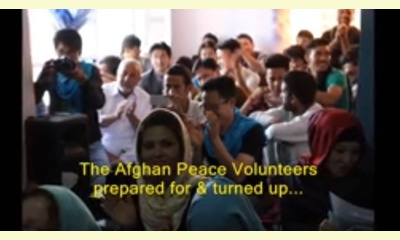|
|
Afghanistan: Borderfree
un article par Kathy Kelly, Voices for Creative Nonviolence
Video: Afghan Peace Volunteers
Here in Kabul, Sherri Maurin and I are guests of the Afghan
Peace Volunteers’ recently formed live-in community for
young women. Hollyhocks in the garden reach as high as the
second floor of our living space. Rose bushes, morning
glories and four-o-clocks have bloomed, and each day we
eat tomatoes, mint and green onions plucked from the well-
cared for garden. The water source is a hose and tank
outside, (there’s no indoor plumbing) so dishes and clothes
are cleaned outside. The latrine is also outside, —and
unfortunately we’re sharing it with playful kitties, but
otherwise Zarghuna, Zahidi and Zahro have managed to
efficiently manage almost every detail of housekeeping, each
day, by 7:00 a.m. 
The Afghan Peace Volunteers Prepared for and tuned up
click on photo to enlarge
A group of local seamstresses also have two rooms here, but
lately they have been with their families as Ramadan came to
a close followed by Eid celebrations.
The men’s community, separate now from the newly
launched “Borderfree Community Center of Nonviolence,”
where projects and programs take place, also has a fine
garden and similar room arrangements. An added plus, -
their yard has four trees!
Going and coming from our communities to “the center” is a
35 minute walk through village-like streets if you take the
back ways. The Borderfree Community Center, when it was
first rented, needed considerable rehab and repairs. Hakim,
Faiz, Zekerullah and Abdulhai worked very hard to shape it
up. Now, guests enter an attractive space, neatly painted,
with plenty of classroom and meeting space. Plants,
curtains, photo exhibits, and choices for rugs and carpets
have all been carefully chosen.
Sadaf, one of the APV women who has been very active
Borderfree scarf production, organized art students from
local Universities to paint images on the walls of a children’s
classroom as well as the reception area. Painted on a wall
inside the center’s gate is a playful graffiti with lots of
floating bubbles. Letters floating in some of the bubbles
spell out “We love Peace,” although certain bubbles have
wafted up and down, making it a challenge for linear
thinkers. Another artist, a well-known cartoonist, painted an
image on the outside wall of the Borderfree Community
Center, (a wall that can be seen by anyone passing by), of a
figure shooting a slingshot at a drone, but instead of a rock,
a red heart breaks the drone in half.
Classes and programs keep the center lively. Earlier this
week, the center invited a small group of people to the first
session of a four week course orienting people to better
understand nonviolence and the APV history and goals. We
also gathered for the weekly Global Awareness sessions
which focus on a wide range of topics related to militarism,
environmental concerns, and socioeconomic inequalities.
Hamidullah Natiq, a seasoned practitioner of conflict
resolution in Afghanistan, meets with the group once a
week. Local children who are part of a “street kids” project
come once a week for Dari and math classes, guided by
Hadisa and Farzana, two capable young volunteer teachers.
And, once a month, the “street kids” receive, for their
families, large sacks of rice and containers of cooking oil.
These donations allow them to attend school rather than
work as vendors on the streets of Kabul.
(This article is continued in the discussionboard)
|








|
DISCUSSION
Il n'y pas encore de question liée à cet article.
* * * * *
Commentaire le plus récent:
(The following is continued from the main article listed above.)
Rent for the center costs $500 per month. The APVs hope that by selling the borderfree sky blue scarves they can help cover this cost. Sherri, I and other internationals will encourage people in our home locales to assist with the center’s expenses.
During a recent visit to the Emergency Surgical Center for Victims of War, here in Kabul, the staff shared with us news that they get about what’s happening around the country. They rely on reports from staff working at several dozen clinics and the two main hospitals they run in two additional provinces. Much of our conversation pointed to the reality that Kabul is “a bubble.” Full scale wars are being fought by heavily armed sides in eastern and southern Afghanistan, but generally the only news coverage that goes beyond Afghanistan pertains to Kabul. The groups fighting the Afghan government include various warlords, the Taliban, drug kingpins, and foreign fighters, some of whom may be strategizing ways to cut off the roads to Kabul. Clearly, the Kabul “bubble” can be quite vulnerable.
I asked Faiz what he most appreciates about the center. He immediately spoke of the graffiti outside, saying that it gives him hope and suggests a sense of freedom. . ... continuation.

|
|









